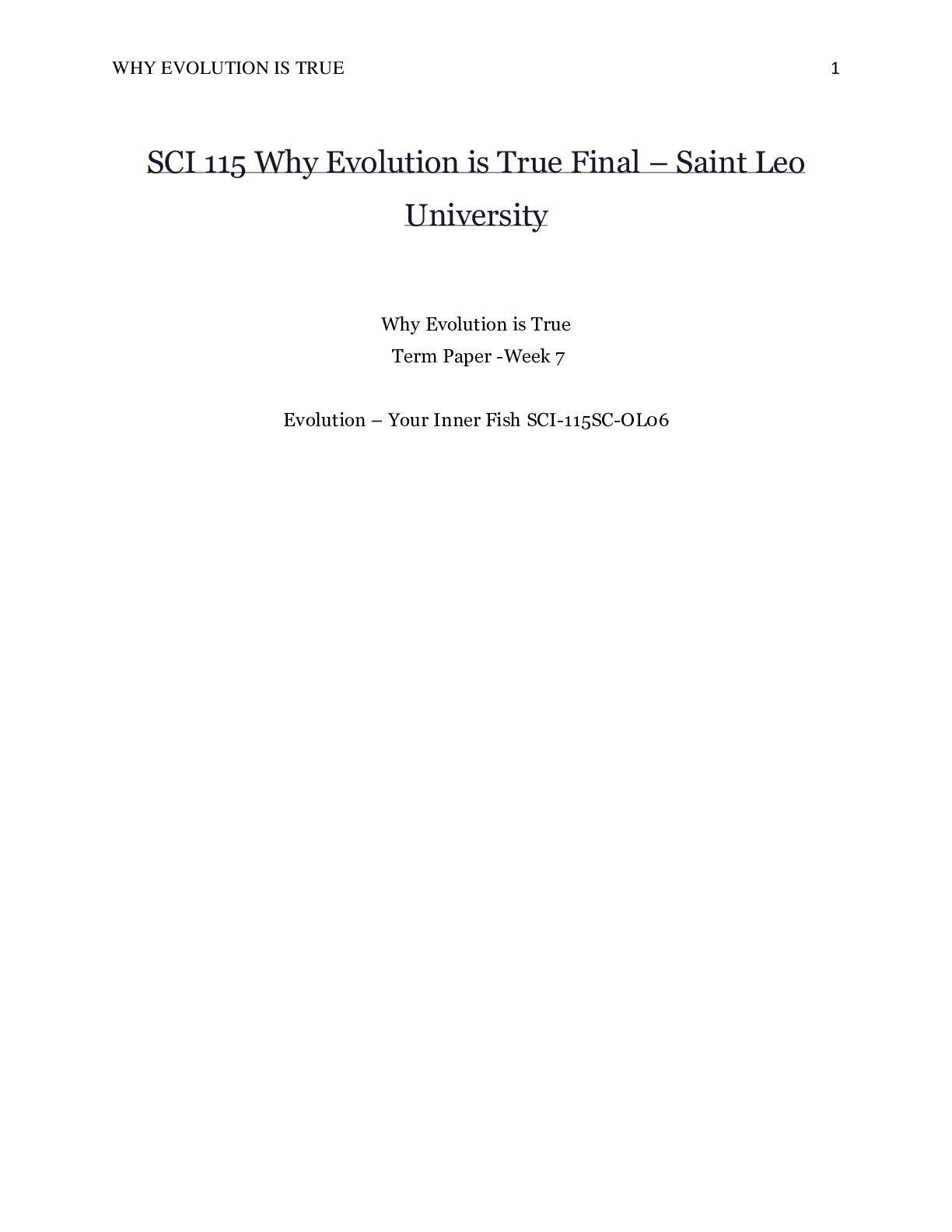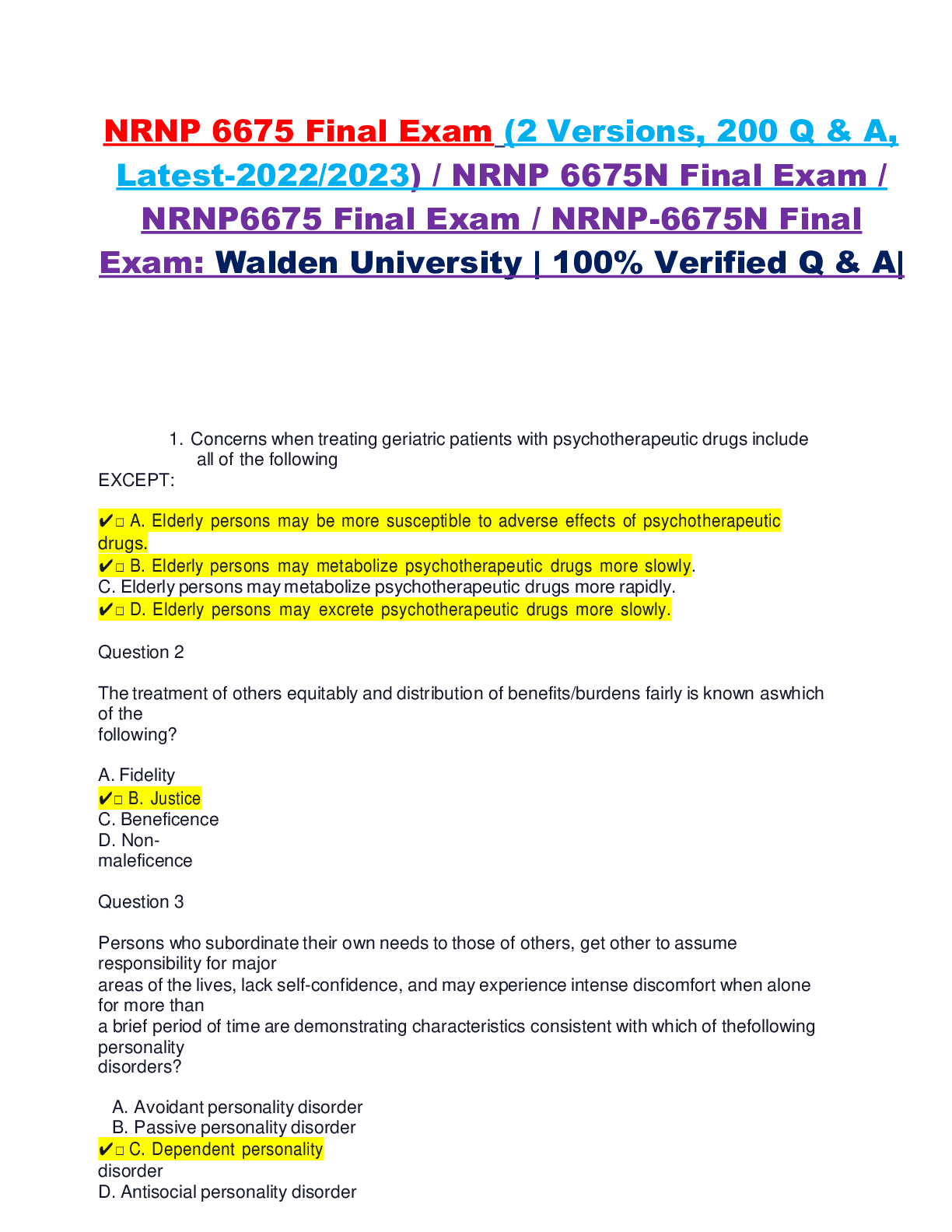Social Sciences > EXAM > SCI 115 Spring I 2019 Final Exam Sat – Saint Leo University | SCI 115 Finding Your Inner Fish (All)
SCI 115 Spring I 2019 Final Exam Sat – Saint Leo University | SCI 115 Finding Your Inner Fish
Document Content and Description Below
SCI 115 Spring I 2019 Final Exam Sat – Saint Leo University SCI 115 Finding Your Inner Fish Spring I 2019 Final Exam Sat Good luck and may the Force be with you! Due Sunday March 3 (Submit v... ia the dropbox) Multiple Choice: Select the best answer for each question 1. _____ The separation of two populations of a species into different environments or territories can result in differences between the two populations. Eventually, they may change enough to become two different species with the original species being a common ancestor. This explains what happened when an opossum like marsupial evolved into today’s koala, kangaroo, and wombat. This is an example of what type of evolution? a. Co b. Convergent c. Divergent d. Punctuated e. Adaptive 2. _____ Dolphins and sharks both exhibit streamlined shapes that help them move smoothly through the water. When unrelated organisms living in similar environments evolve similar characteristics, this is an example of what type of evolution? a. Divergent b. Co c. Convergent d. Punctuated e. Gradual 3. _____ A number of genetic maladies, such as Ellis van Crevold Syndrome, are found in the population of the Amish of Lancaster, Pennsylvania at rates higher than the surrounding general population and the population from which the Amish were originally derived. This is considered an example of what process? a. Bottleneck b. Founder effect c. Heterozygote advantage d. Homozygosis advantage e. Co evolution 4. _____ A severe reduction in population size; detrimental and often catastrophic a. Founder effect b. Resistance c. Assimilation d. Bottleneck e. Artificial selection 5. _____ Random change in allele frequency; fixation or loss of alleles; influences small populations more; not as fast in large populations; loss of genetic variation a. Gene flow b. Genetic equilibrium c. Genetic drift d. Natural selection e. Mutation 6. _____ All of the genes in the population a. Gene pool b. Tree of life c. Genetic equilibrium d. Genetic drift e. Molecular biology 7. _____ Members of species that occupy the same geographical region a. Species b. Population c. Mutants d. Individuals e. Bottleneck 8. _____ Which of the following is an example of disruptive selection? a. The beak sizes of West African birds b. Higher and higher c. Blue and aqua d. Fast and faster e. None of the above 9. _____ Pepper moths in England are an example of what type of selection? a. No directional selection b. Stabilizing selection c. Disruptive selection d. Diversifying selection e. Directional selection 10. _____ The frequency distribution of birth weights in human infants is bell-shaped with birth weights in the middle of the range. What type of selection is this? a. No directional selection b. Directional selection c. Stabilizing selection d. Disruptive selection e. Diversifying selection 11. _____ Allele frequencies are not changing; population is not evolving a. Directional selection b. Disruptive selection c. Genetic equilibrium d. Microevolution e. Stabilizing selection 12. _____ Even if they are physically compatible, an embryo will not form if the egg and sperm do not fuse properly. Which mechanism of reproductive isolation is this? a. Ecological b. Temporal c. Behavioral d. Mechanical e. Gametic 13. _____ Even if they come in contact, they can’t mate if they breed at different times. This represents which mechanism of reproductive isolation? a. Ecological b. Temporal c. Behavioral d. Mechanical e. Gametic 14. _____ Even if they attract one another, they cannot mate if they not physically compatible. Which type of mechanism of reproductive isolation is this? a. Ecological b. Temporal c. Behavioral d. Mechanical e. Gametic 15. _____ Even if they breed at the same time, they will not mate if they are not attracted to one another; species (such as insects and birds) that are highly dependent on courtship displays may not mate if the display is performed improperly or differently by a member of a dissimilar species. This is what mechanism if reproductive isolation? a. Ecological b. Temporal c. Behavioral d. Mechanical e. Gametic 16. _____ Two populations of the same species of squirrels occupy the same range that includes a forest. One of the groups spends all of its time in oak trees; the other spends its time in pine trees. Over a long period of time, the two populations evolve into two species. This is an example of what type of speciation? a. Sympatric b. Allopatric c. Parapatric d. Symphonic e. Nonspecific 17. _____ The classification of organisms based on similarities and differences a. Systematics b. Taxonomy c. Population d. Microevolution e. Reproductive mechanism 18. _____ This type of speciation is the result of a population being separated by geographical barriers a. Co specific b. Sympatric c. Allopatric d. Parapatric e. Symphonic 19. _____ Developed taxonomy a. Darwin b. Mayr c. Linnaeus d. Trump e. Clinton 20. _____ Credited with developing the Biological Species Concept a. Charles Darwin b. Sherlock Holmes c. Ernst Mayr d. Stephen Hawking e. Karl Linnaeus 21. _____ Process of species formation; occurs when populations become isolated a. Bottleneck b. Speciation c. Divergence d. Systematics e. Taxonomy 22. _____ The study of evolutionary relationships among organisms; the classification of organisms based on evolutionary relatedness a. Systematics b. Evolution c. Toxicology d. ESP 23. _____ Irrevocable loss of a species a. Cladogenesis b. Anagenesis c. Gradualism d. Extinction e. Punctuated equilibrium 24. _____ Species may prefer different habitats, so seldom or never cross paths for mating; even if they live in the same place, they can’t mate if they don’t come in contact with one another. This represents which mechanism of reproductive isolation? a. Ecological b. Temporal c. Behavioral d. Mechanical e. Gametic 25. _____ Developed the five kingdom scheme a. Mayr b. Linnaeus c. Whitaker d. Frost e. Darwin 26. _____ Represented by “Turkana boy;” adolescent boy; would have reached 6 ft.; first dramatic change seen in Homo lineage; larger brain case than any Australopithecus a. Homo hablis b. Homo ergaster c. Homo erectus d. Homo neanderthalensis e. Homo sapien 27. _____ Modern humans a. Homo erectus b. Homo ergaster c. Homo sapien d. Homo hablis e. Homo neanderthalensis 28. _____ First member of the genus Homo; lived in the woodlands a. Homo habilis b. Homo ergaster c. Homo erectus d. Homo floriensis e. Homo neanderthalensis 29. _____ On what continent did the earliest human ancestors originate? a. Australia b. Asia c. North America d. Africa e. Antarctica 30. _____ Gave rise to the genus Homo; had a bipedal stance; the most famous skeleton of Australopithecus afarensis a. Desi b. Fred c. Ethel d. Lucy e. Ricky 31. _____ These fossils were found in South Africa; small brain; modern looking jaws, teeth, and feet; indication of possible burial rites a. Homo naledi b. Homo erectus c. Homo neanderthalensis d. Homo habilis e. Homo sapien 32. _____ Early humans that lived in Europe and Near East; massively built, with large brains; disappeared when Homo sapiens appeared; DNA evidence suggests that they did not contribute to modern European populations; evolutionary dead end a. Homo hablis b. Homo erectus c. Homo ergaster d. Homo neanderthalensis e. Homo floriensis 33. _____ Evolved in Africa; migrated into Europe and Asia about 1.5 million – 2 million years ago; had a larger brain than Homo habilis; was a creative toolmaker; built fires and used furs for clothing; evolutionary dead end a. Homo ergaster b. Homo sapien c. Homo neanderthalensis d. Homo floriensis e. Homo erectus 34. _____ One branch in the family of man-like creatures a. Androids b. Hominids c. Vulcans d. Romulans e. Borg 35. _____ Small hominid; lived around 18,000 years ago; believed to be an offshoot of Homo erectus; found on the Indonesian island of Flores a. Homo neanderthalensis b. Homo sapian c. Homo floriensis d. Homo ergaster e. Homo hablis [Show More]
Last updated: 1 year ago
Preview 1 out of 16 pages
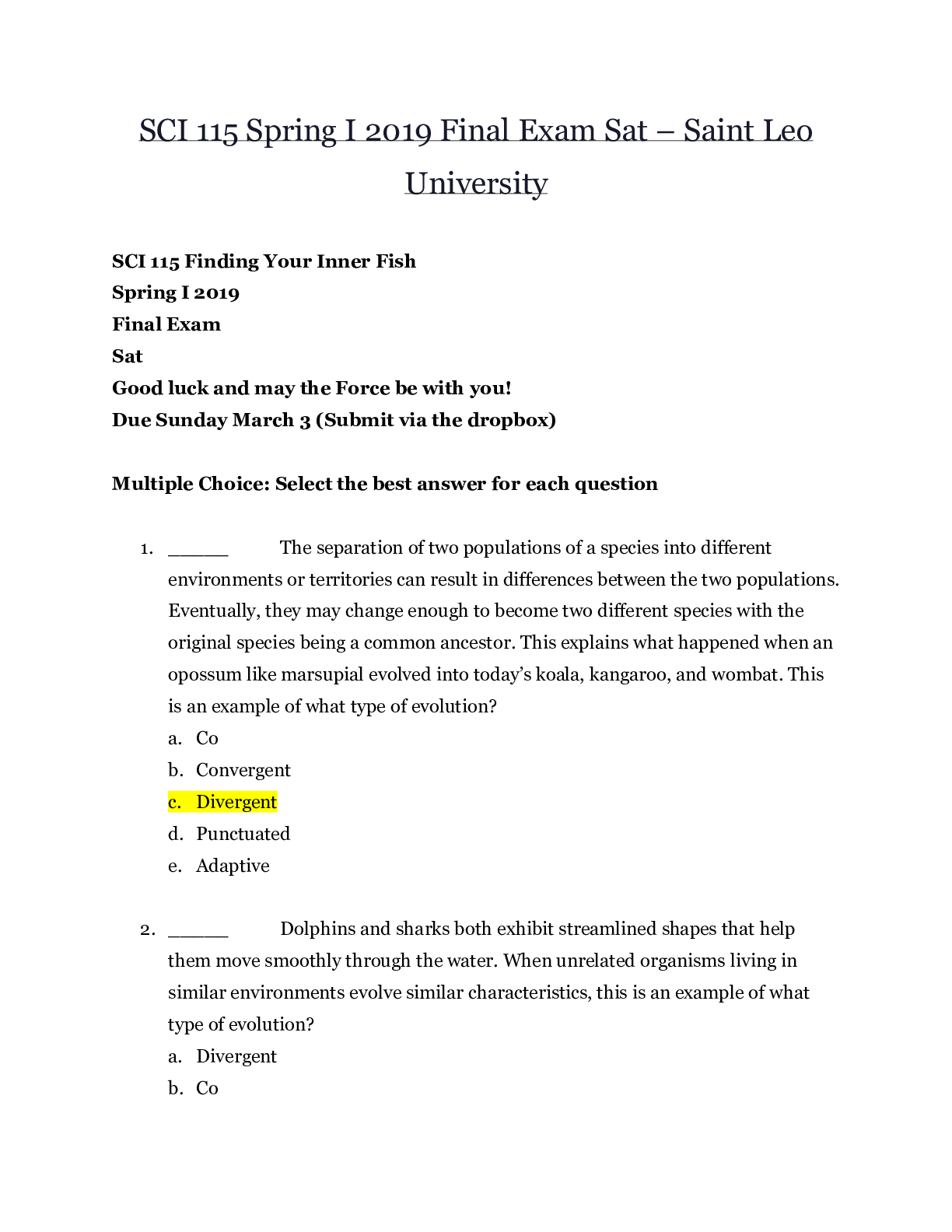
Reviews( 0 )
Document information
Connected school, study & course
About the document
Uploaded On
Sep 01, 2020
Number of pages
16
Written in
Additional information
This document has been written for:
Uploaded
Sep 01, 2020
Downloads
0
Views
69














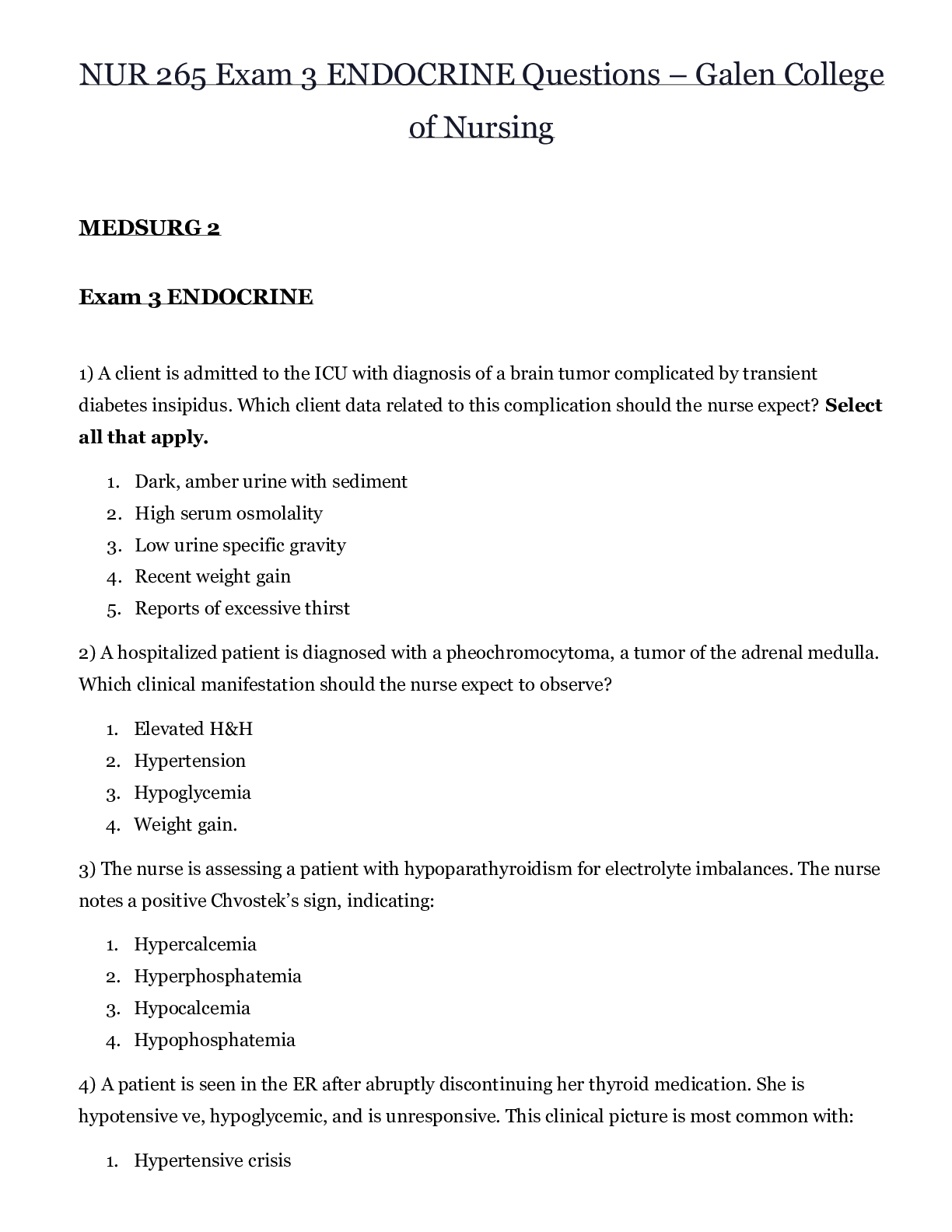
 – CHAMBERLAIN COLLEGE OF NURSING.png)
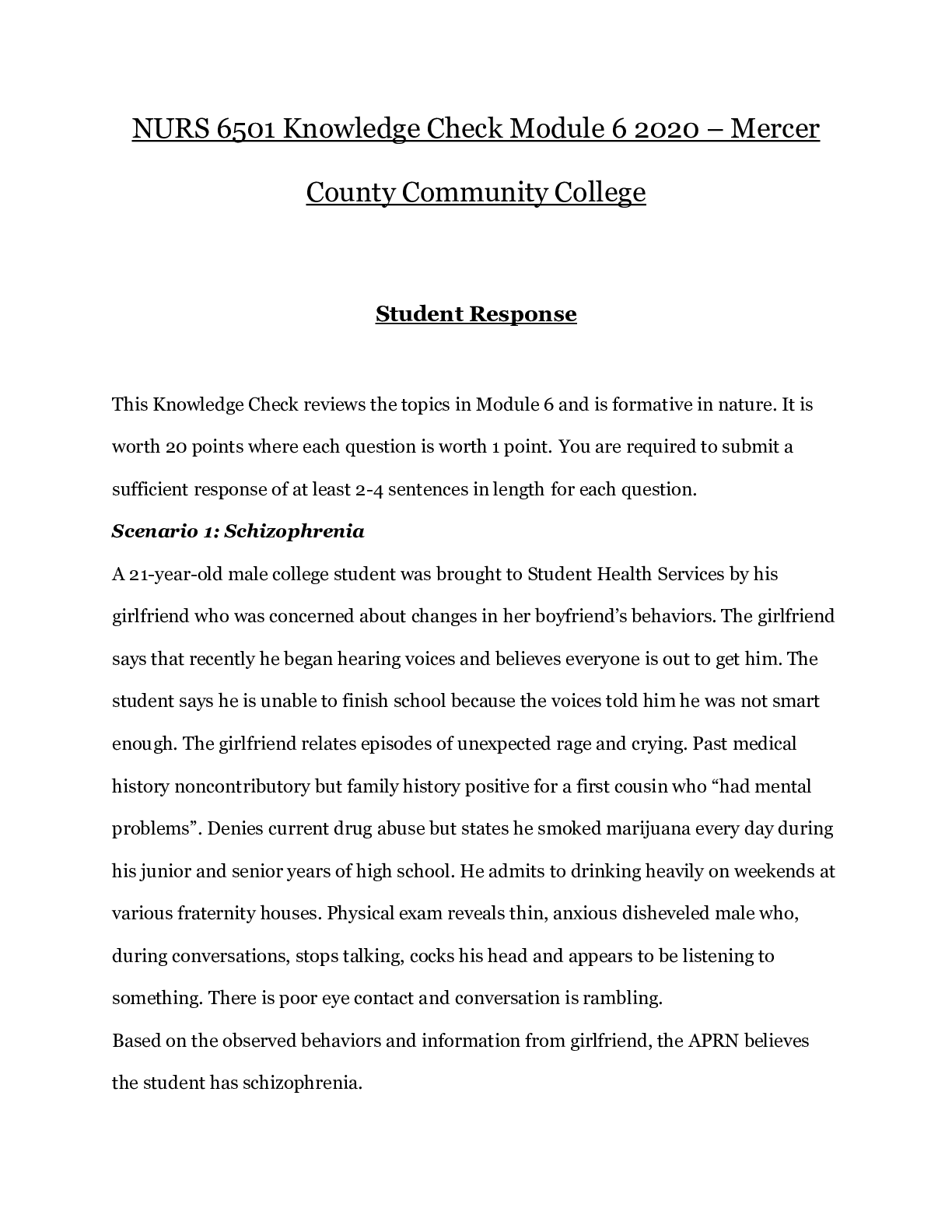

 – Saint Leo University.png)
